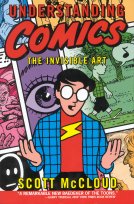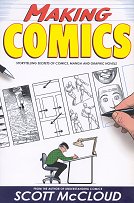Scott McCloud argues passionately that there is nothing intrinsic to the format of comics that stops it being Art -- and in fact, that there is something to the format, "Sequential Art", that allows it to do things simply not possible with other formats.
Writing in the style he is arguing for, McCloud leads us through some of the conventions that have evolved over the lifetime of comics, such as depicting motion and time, the iconography, why foreground characters and backgrounds may be drawn with different degrees of realism, and the different kinds of transition between panels -- including how these styles have evolved subtly differently in Japan and the West. I have subliminally noticed some of these techniques and styles, so it is fascinating to have them made explicit like this.
His main argument is that the art form allows something to happen "in the gutter", in the space between the panels, that is, in the reader's head. And that this is a kind of thing that doesn't happen in other graphic art forms, like single pictures (there are no gutters) or films (there is no time for it to happen). This is the kind of process that Lois McMaster Bujold refers to in her essay "The Unsung Collaborator". In Donald Norman's terminology, comics is a "reflective" rather than an "experiential" medium.
All in all, this makes deeply interesting reading. If you read comics already, it will help you appreciate how some of the effects are achieved. If you don't, because comics are just "trashy kids' stuff", this may very well change your mind -- about the format, if not about all of its instantiations, at least.


